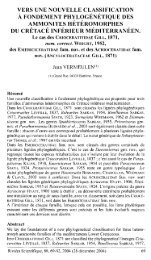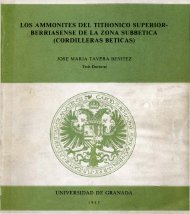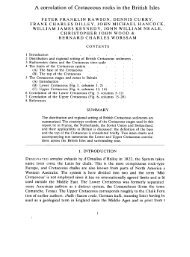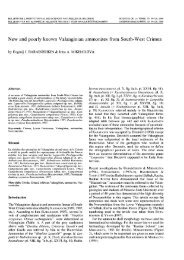thiolliericrinid crinoids from the lower cretaceous of crimea
thiolliericrinid crinoids from the lower cretaceous of crimea
thiolliericrinid crinoids from the lower cretaceous of crimea
Create successful ePaper yourself
Turn your PDF publications into a flip-book with our unique Google optimized e-Paper software.
— 627 —Fig. 1 —Localities <strong>of</strong> Thiolliericrinidae in <strong>the</strong> Crimea.Gisements à Thiolliericrinidae en Crimée.Chornaya Basin (1 - Kuchky, 2 - Rodnoie), Belbek valley (3 - Belbek, Kuibyshevo, 4 - Karatlykh, 5 - Chuku), 6 - Bairakly, 7 - Tass-Kor Ravin (Mramornoie), 8 - Beshterek, 9 - Mezhgorie, 10 - Tanass (Alekseevka and Krasnossiolovka).Thiolliericrinidae are found but extremely rarely in<strong>the</strong>se bioherms ;- 2 :« barrier » reefs. They have large volumes (upto 15 m thick and several hundred metres long), built<strong>of</strong> big nodules <strong>of</strong> <strong>the</strong> calcareous algae and, rarely,colonial corals. Here, in <strong>the</strong> reef rocks, lenses <strong>of</strong> <strong>the</strong>coarse-grained sandstones and « pockets » saturatedby <strong>the</strong> quartz pebble are frequent. One can note,among reef-dwellers (besides above mentioned oysters),Prohinnites, Trichites, Heterodiceras and alsonerineid gastropods and so on. The locality on <strong>the</strong>Chuku Mountain is <strong>the</strong> example <strong>of</strong> such « barrier »reef. Rare columnals and calyxes <strong>of</strong> Heberticrinusheberti were found here ;- 3 : «tower-like » bioherms, are <strong>the</strong> intermediatetype between <strong>the</strong> two previous ones. They show a discoidshape with an average size (<strong>the</strong> height is not morethan 7-8 m with <strong>the</strong> diameter up to 15-20 m) <strong>the</strong> framework<strong>of</strong> <strong>the</strong>se bodies is built by cloddy masses,consisting <strong>of</strong> skeletons <strong>of</strong> colonial hexacorals, hydrozoansand calcareous algae. The interstices betweenbodies <strong>of</strong> <strong>the</strong> reef-forming organisms are filled withloose calcareo-argillaceous masses. Therefore <strong>the</strong> characteristictube-like forms appear in <strong>the</strong> process <strong>of</strong>wea<strong>the</strong>ring <strong>of</strong> <strong>the</strong>se bioherms. Small oysters, brachiopods(Craniscus sp., Ismenia cf. perilustrus Sm ir n o v a and o<strong>the</strong>rs), calcareous sponges, bryozoans,small solitary corals, serpulids and o<strong>the</strong>rs organismsalso are among <strong>the</strong> reef-dwellers. Traces <strong>of</strong> boring
















